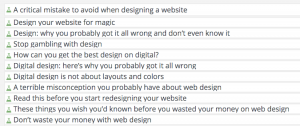“The 21st century does not have room anymore for companies that are not centered on their users.”
From “I want” to “my users want”
The eagerness to launch a great and gorgeous website is a good energy to feed on; unfortunately it can easily get the best of you. It’s easy to get carried away: you know what you want to say, you know you want it to be pretty, you might even have an idea of design and/or features that made you tick on that website you like.
We’ll be honest: most of us have been there before. But here’s a hard truth: having a very accurate idea of what you want is not enough, and can sometimes even be counter-productive.
As a user you probably don’t notice it, but behind every successful website there is a lot of research, testing and optimization going on permanently. What matters is that you crack the code to please the people that will be visiting your website. You’ve heard it before, the 21st century does not have room anymore for companies that are not centered on their users.
Wild guess vs. design
You do not want to spend your money away for no result, and that is good news. But what happens when you go to an agency or designer with an old-school brief saying: “here’s what the content should be, how it should look, the features that should be there, now let’s go and develop it”?
The problem is: unless you have previously conducted some significant user testing yourself, you basically have no visibility on how your users will respond to your ideas until you make them try. You’re thinking of launching a product without knowing if it’s going to fly or crash. It’s not design, it’s a wild guess.
Designing, you’ll often hear, is solving a problem. And it can be an overwhelming one.
A proper design process begins by asking the right questions, and gathering the corresponding data to make informed decisions. User Experience (UX) professionals are capable of getting the insights and data from your users, and put them first so they enjoy to spend their time -and money- on your digital space. What they do: put the users at the center of your site or app. They test options with real people so you know what works and what doesn’t. And they adapt accordingly.
They use appropriate tools and methods such as eye-tracking, card sorting or split testing to scientifically create and modify your product over time. There is no longer room for guessing, this is informed investing. The title of this article was tested against a dozen alternatives and we picked the one that performed the best.

The title of this article was tested against a dozen alternatives and we picked the one that performed the best.
“We shift the focus from digital decoration to real, problem-solving design”
Moving away from plastic surgery
Now here’s the challenge if you go with an agency: as a client you want to see what you will get. You want a sample of the final result you’ll be paying for. It may feel a bit like going to plastic surgery: you know you have to rely on the professional about the end result, but you want to know as clearly as you can what it will look like. And for a long time, websites have been treated in a similar way.
The problem is: user-centered design is essentially very different from plastic surgery. We do not try to copy templates or sites, and most importantly we do not decide upfront what your site or app will look like. We want to make your digital platform healthy and beautiful from inside-out. What we do is listen, diagnose, test first, before we make decisions.
In a word, we shift the focus from digital decoration to real, problem-solving design. That means we do what it takes to train your platform into a healthy digital champion that delivers consistently the experience that will make your users love you.
Improve the experience, again and again
Keeping your users happy is a never ending journey. Constant improvements of technology and competition should always push you to do more. Would you trade your smartphone for a good old Nokia for your daily needs? Probably not. As long as the world is functioning as a free-market economy, the user expectations will always be higher. So you need to test constantly: what made your users delighted 2 years ago might become a frustration point before you know.
“If it’s not user-centered and if it’s not insight-based, don’t call it design.”
The right thing for your baby
Taz, one of our UI designers, found a good metaphor to explain the right attitude to have when you (re)build your website. Almost every time, coming up with a website redesign feels like a parenting experience. It’s your baby and you take it very personal. The baby should be a reflection of what’s best about you. Of course, you want the best for your baby, and you have a pretty good idea of how you want your baby to be, look like, behave.
But babies grow up. And they do not leave in isolation. They are more than their parent’s favourite thing and need to grow a personality of their own. More importantly, they need to fit within the society around them if they are to be successful. Same thing goes about the digital platform you’re building: it should be designed to take the users’ expectations into account – or it will be rejected.
Starting with Design
Let this be clear about the design process: if it’s not user-centered and if it’s not insight-based, don’t call it design. So what kind of insights do you need to get it right?
• Needfinding: what are your users looking for? What do they have to do with you? What is their search behavior?
• Context of use: where are people using it? At what point in their day do (or should) they decide to use your service?
• User journeys: between the moment users land on your site and exit from it, what happens? What path do they follow? Where do they drop out? Why?
• Frustration points: what are the gaps between the users’ expectations and their experience? How do we bridge them? Which ones do we start with?
Data-based answers to these questions are exactly what User Experience professionals put at the core of their design approach. It is the basis of the credible, informed design decisions that will give your site the backbone it takes to make the magic happen – except now you know the magicians’ trade secret.



